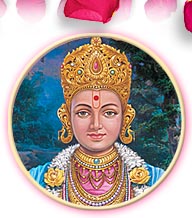|
Early
Days, Leaving Home
Bharatvarsha
- India has been graced since time immemorial by incarnations,
rishis and sadhus. Whenever evil elements stifle Dharma - righteousness,
God incarnates on earth to re-establish Dharma. Lord Ramchandra
in the age of Treta and Lord Krishna, at the end of Dwapar, are
the two most notable.
Five thousand years after Lord Krishna passed away, into the age
of Kali - darkness, the ogre of evil defiantly arose out of its
banishment, once again darkening the minds and hearts of the people,
its grip suffocating eighteenth century India. Severing vital
nerves and arteries, it deprived the land of life-giving moral
and spiritual nourishment; hindering healthy growth of the eternal
values of Dharma, Satya - truth, Ahimsa - non-violence and Brahmacharya
- celibacy.
Thus He incarnated as Ghanshyam on 3rd April 1781 (Chaitra Sud
9, Samvat 1837), in the rustic village of Chhapaiya, in northern
India, to a Sarvaria brahmin pundit named Hariprasad Pande. He
was the second of three sons; Rampratap, the elder brother and
Ichharam, the younger. His mother, Premvati was lovingly known
as Bhaktimata, and father Hariprasad as Dharmadev.
When Ghanshyam was three months old, a sage astrologer named Markandeya,
studied His zodiac signs. He then revealed to Dharmadev,
"Since He is born in the Kark Rashi (sign of Cancer in the zodiac),
His name will be Hari. His dark complexion will also confer the
name Krishna and Ghanshyam. He has the virtues of tapas (austerity),
detachment, yoga, Dharma, leadership, truth and vivek (power of
discrimination). Therefore people will also call Him Neelkanth.
"He will establish Dharma on earth and remove pain and misery
from people. He will be famed all over the land. He will also
induce people with samadhi (a state of spiritual trance). He will
lead people to the path of God."
About this time, Dharmadev decided to test Ghanshyam's innate
instincts. He placed a gold coin, a scripture, and a sword on
the floor. On all fours, Ghanshyam toddled towards these objects;
trying to lift the scripture, avoiding the other two. Dharmadev
jubilantly lifted and hugged Him, deducing that He would surely
attain scriptural learning.
Ghanshyam's first encounter of animal slaughter for food occurred
during His stay in Chhapaiya.
In a town named Ballampaddhari near Chhapaiya, the state king
had recently camped with his army. Two of the soldiers were Dharmadeva's
relatives. Therefore Dharmadev decided to visit them with Rampratap
and Ghanshyam. When they reached the encampment, they heard goats
causing a commotion in one of the tents. Dharmadev peeped inside.
Horrified at what he saw, he quickly turned back. But Ghanshyam,
observing Dharmadev's ashen face, also walked up to the tent in
curiosity. He saw the king supervising the slaughter of the goats
for food.
Ghanshyam walked away in pain. He then induced all the elephants
and horses of the army to break tether and stampede towards the
tent. The king bolted out first, and heard a mysterious and authoritative
voice, which commanded him to beg forgivance for the killing,
from the Lord who was standing in the form of a little boy nearby.
The king saw Ghanshyam with Dharmadev and Rampratap. He bowed
at Ghanshyam's feet, begging for reprieve from the maddened elephants.
Ghanshyam not only made him promise to renounce animal slaughter
but to propagate Ahimsa (non-injury in mind, action and speech
for all living creatures) in his kingdom as well. The excited
elephants and horses calmed down instantly, returning to their
tethers.
On another occasion, Ghanshyam revived a basketful of dead fish
in a lake. He then instructed the surprised fisherman not to commit
such sin by changing his means of livelihood.
Having lived in Chhapaiya for a few years, the family moved to
nearby Ayodhya, when Ghanshyam was five, to escape harassment
from evil people.
With a marked inclination for devotion and a remarkable disinterest
towards material pursuits, Ghanshyam loved to visit mandirs every
morning and evening. After darshan (sight) of the murtis (icons),
He would listen to the narration of divine episodes from the Ramayana,
for this ancient sacred city is revered as the birthplace of Lord
Rama.
Ghanshyam's divine disposition often startled but pleased the
family. Engrossed in katha (scriptural exegesis) once, He forgot
to return home. Rampratap, His elder brother searched for Him
in the city's mandirs. On seeing Ghanshyam in one, he asked Him
to return home with him. The katha nearly over, Ghanshyam suggested
that Rampratap, in the meantime, have darshan in the neighbouring
mandir while He Himself sat through to the end of the katha. Arriving
at the nearest mandir, Rampratap, to his astonishment, saw Ghanshyam
there as well. He then dashed from one mandir to the next. He
saw his younger brother in each one!
Other miracles included: walking on water across a lake, and defeating
adult wrestlers in contests.
At the age of eight He commenced Sanskrit studies under Dharmadev
after being invested with the yagnopavit rite. By the age of ten,
the child prodigy had mastered the Vedic scriptures.
Around this period, He accompanied Dharmadev, who was to chair
a scholarly debate in Benares - the renowned centre of knowledge
(Jnan) in India. When a tie arose, Ghanshyam, with Dharmadev's
permission, gave a brilliant exposition, convincing the scholars
of the soundness of the Vishishtadvait philosophy (qualified non-dualism).
Leaving
Home
Soon after returning from Benares, both parents passed away. Ghanshyam
then left Ayodhya, for the Himalayas, to begin His life work of
establishing Ekantik Dharma, on 29th June 1792 (Ashadh Sud 10th,
Samvat 1849). He was only eleven years old.
His mendicant garb consisted of only a loin cloth. He carried
an icon of Bal Mukund (the Lord) and His miniature diary containing
the gist of the scriptures, the result of His studies with Dharmadev.
|









